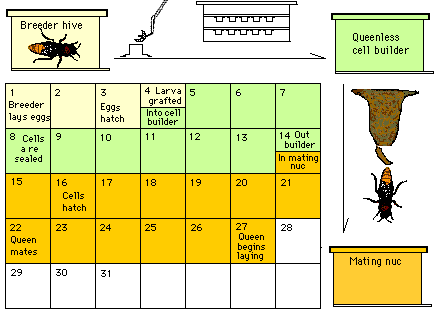Queen Rearing for Commercial and Hobby Beekeepers
2022-07-27
Requirements for Successful Queen Rearing
- 1. A good breeder queen to graft larva from.
- 2. Grafting requires good light, good eyesight or appropriate magnification.
- 3. Grafting larva of the proper age (1-24 hrs old).
- 4. Queen rearing equipment (grafting tool, cell cups, cell bars and frame) can be made or purchased. Some queen kits eliminate grafting
- 5. Natural mating requires 69 degree temps. and mature drones (15 days old)
- 6. Several good books on queen rearing explain the principles of bee biology.
- 7. Queen rearing classes.
A Simple Queen Rearing Technique
-
Day 1 - Give breeder hive an empty dark brood comb to lay eggs in.
- Day 4 - Transfer (graft) larva into artificial queen cell cups, from the breeder comb. Place the frame into a strong colony (cell builder) made queenless the day before.
- Day 14 - Remove completed cells from cell builder. Leave one cell behind to replace the queen. Keep queen cells warm (80-94 F) until they are placed in queenless hives (mating nucs).
- Day 22 - Virgin queens are ready to mate. They require nice weather (69 F), and an abundance of drones to mate with. A few colonies within a mile are adequate for providing drones for mating.
- Day 27 - If queens mate without weather delay, they should now be laying eggs.
- Weather delays in mating will add days to the process, after 3 weeks delay, virgin queens may start to lay unfertilized eggs.
- Time your activities so that warm temperatures and drones are available when the queens are ready to mate.

Previous:
How to Sugar Roll for Varroa Count
Please Feel free to give your inquiry in the form below.We will reply you in 24 hours.



